LCBB5002 Management Accounting Report: Variance Analysis and Decisions
VerifiedAdded on 2023/01/07
|11
|3155
|78
Report
AI Summary
This report delves into the realm of management accounting, specifically focusing on variance analysis as a tool for evaluating organizational performance and supporting decision-making. It commences with an introduction to management accounting and variance analysis, followed by a detailed examination of various variances, including sales price, sales volume contribution, material price planning, and material price operational variances. The report provides calculations and interpretations for each type of variance. Furthermore, it critically evaluates the advantages and disadvantages of utilizing variances in assessing managerial performance. The report also includes an analysis of make-or-buy decisions within the context of management accounting. The analysis highlights the importance of variance analysis in identifying areas for improvement, risk reduction, and ensuring that business objectives are met. The report concludes by summarizing the key findings and implications of the analysis.
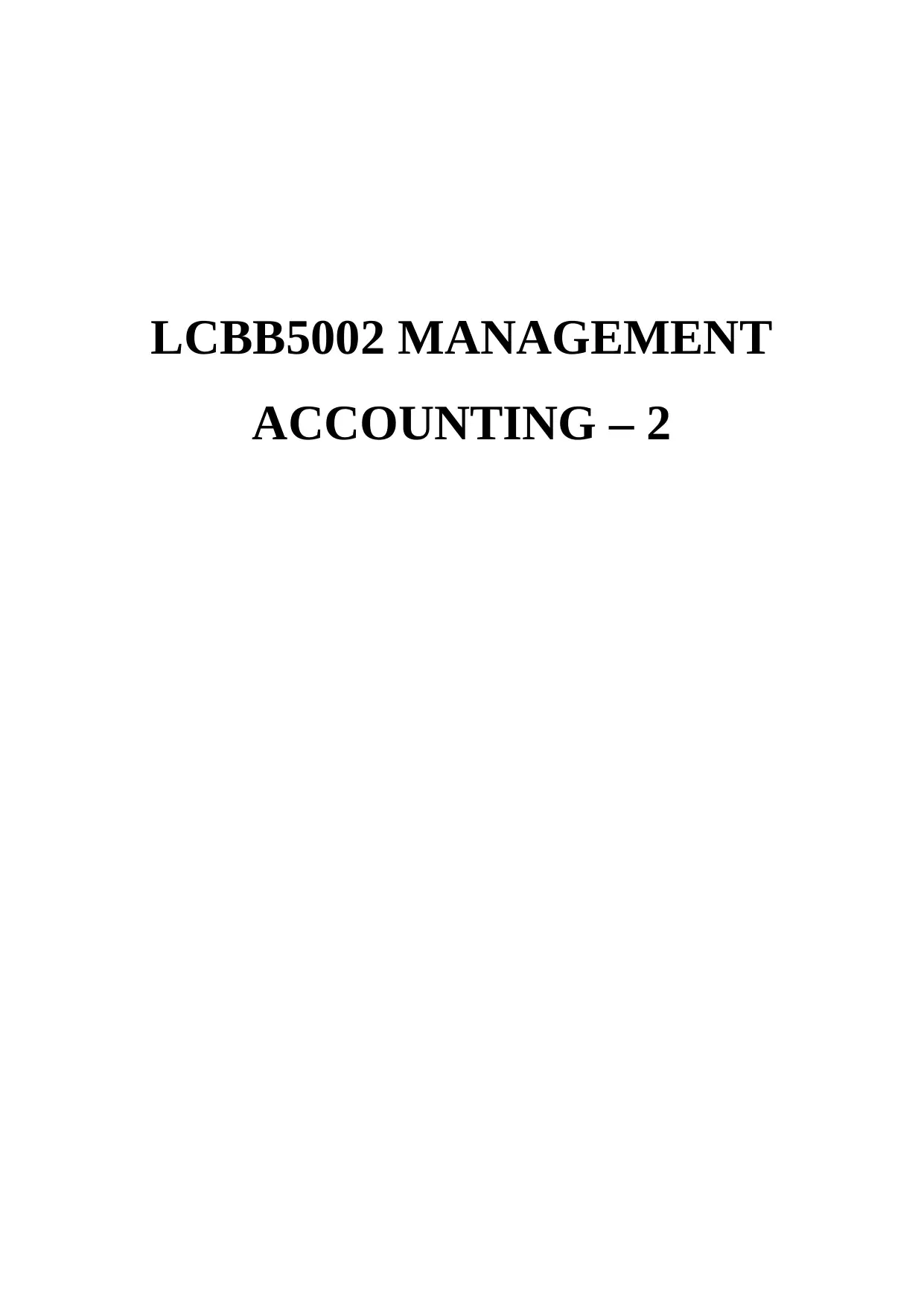
LCBB5002 MANAGEMENT
ACCOUNTING – 2
ACCOUNTING – 2
Paraphrase This Document
Need a fresh take? Get an instant paraphrase of this document with our AI Paraphraser
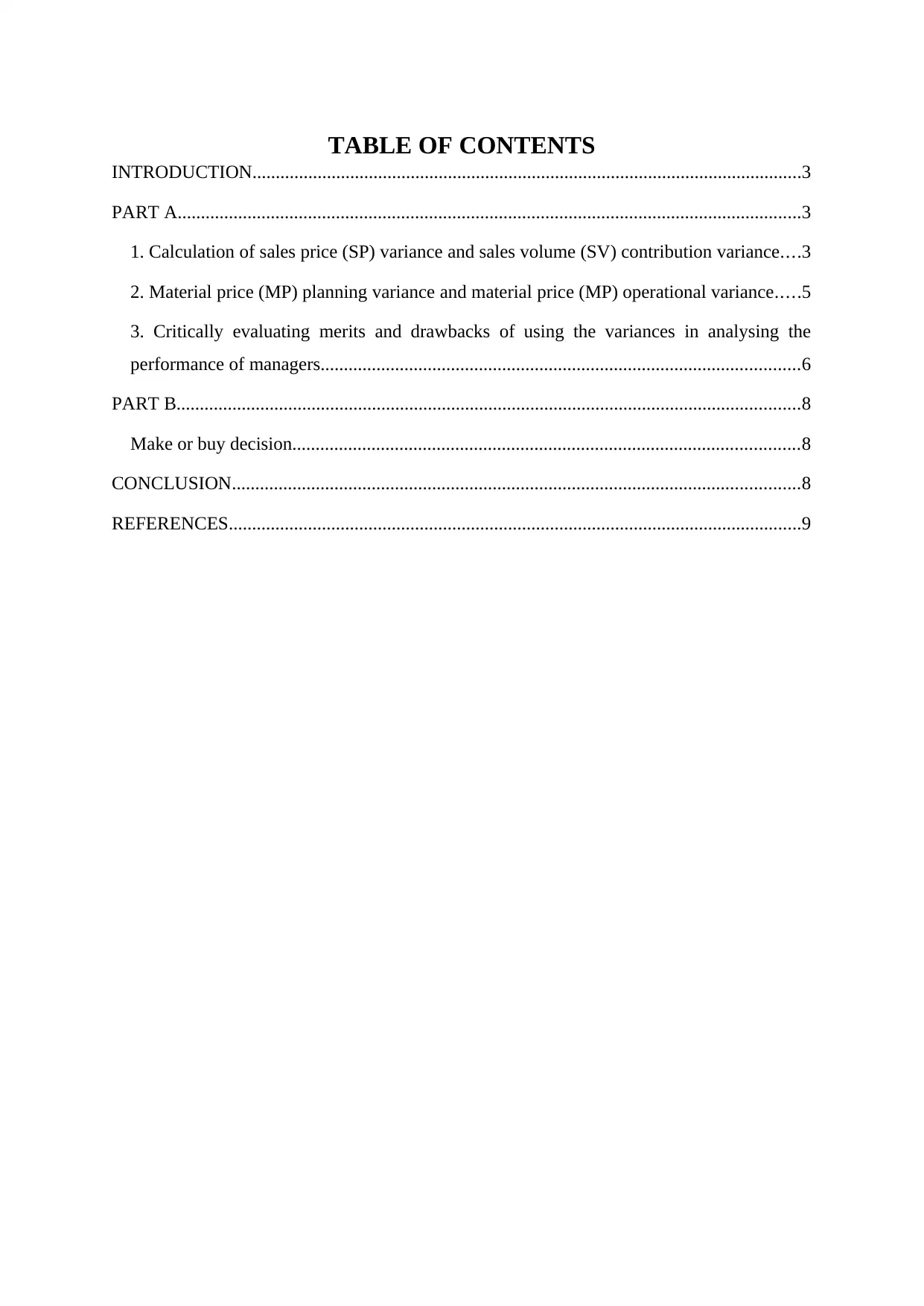
TABLE OF CONTENTS
INTRODUCTION......................................................................................................................3
PART A......................................................................................................................................3
1. Calculation of sales price (SP) variance and sales volume (SV) contribution variance....3
2. Material price (MP) planning variance and material price (MP) operational variance.....5
3. Critically evaluating merits and drawbacks of using the variances in analysing the
performance of managers.......................................................................................................6
PART B......................................................................................................................................8
Make or buy decision.............................................................................................................8
CONCLUSION..........................................................................................................................8
REFERENCES...........................................................................................................................9
INTRODUCTION......................................................................................................................3
PART A......................................................................................................................................3
1. Calculation of sales price (SP) variance and sales volume (SV) contribution variance....3
2. Material price (MP) planning variance and material price (MP) operational variance.....5
3. Critically evaluating merits and drawbacks of using the variances in analysing the
performance of managers.......................................................................................................6
PART B......................................................................................................................................8
Make or buy decision.............................................................................................................8
CONCLUSION..........................................................................................................................8
REFERENCES...........................................................................................................................9
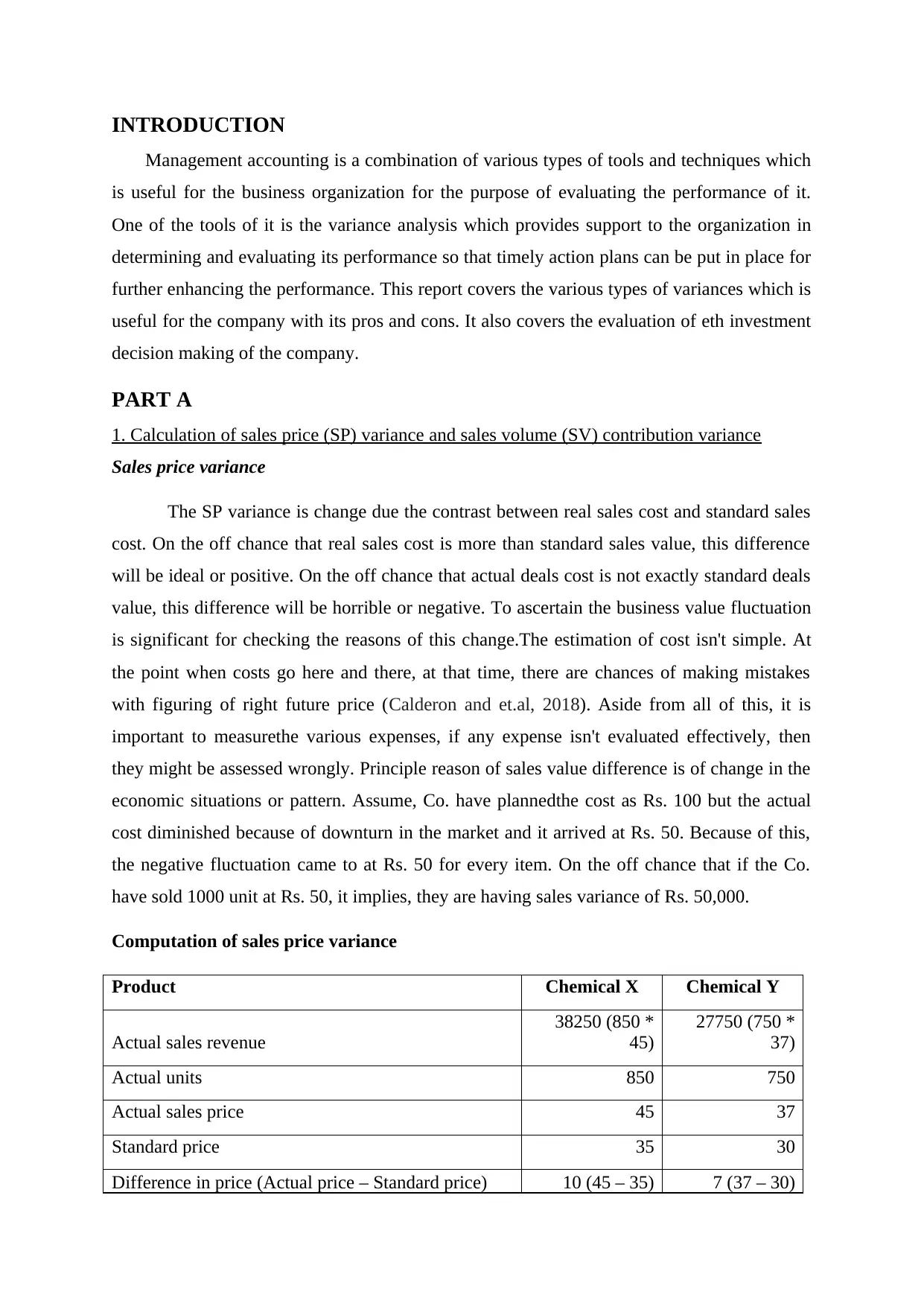
INTRODUCTION
Management accounting is a combination of various types of tools and techniques which
is useful for the business organization for the purpose of evaluating the performance of it.
One of the tools of it is the variance analysis which provides support to the organization in
determining and evaluating its performance so that timely action plans can be put in place for
further enhancing the performance. This report covers the various types of variances which is
useful for the company with its pros and cons. It also covers the evaluation of eth investment
decision making of the company.
PART A
1. Calculation of sales price (SP) variance and sales volume (SV) contribution variance
Sales price variance
The SP variance is change due the contrast between real sales cost and standard sales
cost. On the off chance that real sales cost is more than standard sales value, this difference
will be ideal or positive. On the off chance that actual deals cost is not exactly standard deals
value, this difference will be horrible or negative. To ascertain the business value fluctuation
is significant for checking the reasons of this change.The estimation of cost isn't simple. At
the point when costs go here and there, at that time, there are chances of making mistakes
with figuring of right future price (Calderon and et.al, 2018). Aside from all of this, it is
important to measurethe various expenses, if any expense isn't evaluated effectively, then
they might be assessed wrongly. Principle reason of sales value difference is of change in the
economic situations or pattern. Assume, Co. have plannedthe cost as Rs. 100 but the actual
cost diminished because of downturn in the market and it arrived at Rs. 50. Because of this,
the negative fluctuation came to at Rs. 50 for every item. On the off chance that if the Co.
have sold 1000 unit at Rs. 50, it implies, they are having sales variance of Rs. 50,000.
Computation of sales price variance
Product Chemical X Chemical Y
Actual sales revenue
38250 (850 *
45)
27750 (750 *
37)
Actual units 850 750
Actual sales price 45 37
Standard price 35 30
Difference in price (Actual price – Standard price) 10 (45 – 35) 7 (37 – 30)
Management accounting is a combination of various types of tools and techniques which
is useful for the business organization for the purpose of evaluating the performance of it.
One of the tools of it is the variance analysis which provides support to the organization in
determining and evaluating its performance so that timely action plans can be put in place for
further enhancing the performance. This report covers the various types of variances which is
useful for the company with its pros and cons. It also covers the evaluation of eth investment
decision making of the company.
PART A
1. Calculation of sales price (SP) variance and sales volume (SV) contribution variance
Sales price variance
The SP variance is change due the contrast between real sales cost and standard sales
cost. On the off chance that real sales cost is more than standard sales value, this difference
will be ideal or positive. On the off chance that actual deals cost is not exactly standard deals
value, this difference will be horrible or negative. To ascertain the business value fluctuation
is significant for checking the reasons of this change.The estimation of cost isn't simple. At
the point when costs go here and there, at that time, there are chances of making mistakes
with figuring of right future price (Calderon and et.al, 2018). Aside from all of this, it is
important to measurethe various expenses, if any expense isn't evaluated effectively, then
they might be assessed wrongly. Principle reason of sales value difference is of change in the
economic situations or pattern. Assume, Co. have plannedthe cost as Rs. 100 but the actual
cost diminished because of downturn in the market and it arrived at Rs. 50. Because of this,
the negative fluctuation came to at Rs. 50 for every item. On the off chance that if the Co.
have sold 1000 unit at Rs. 50, it implies, they are having sales variance of Rs. 50,000.
Computation of sales price variance
Product Chemical X Chemical Y
Actual sales revenue
38250 (850 *
45)
27750 (750 *
37)
Actual units 850 750
Actual sales price 45 37
Standard price 35 30
Difference in price (Actual price – Standard price) 10 (45 – 35) 7 (37 – 30)
⊘ This is a preview!⊘
Do you want full access?
Subscribe today to unlock all pages.

Trusted by 1+ million students worldwide
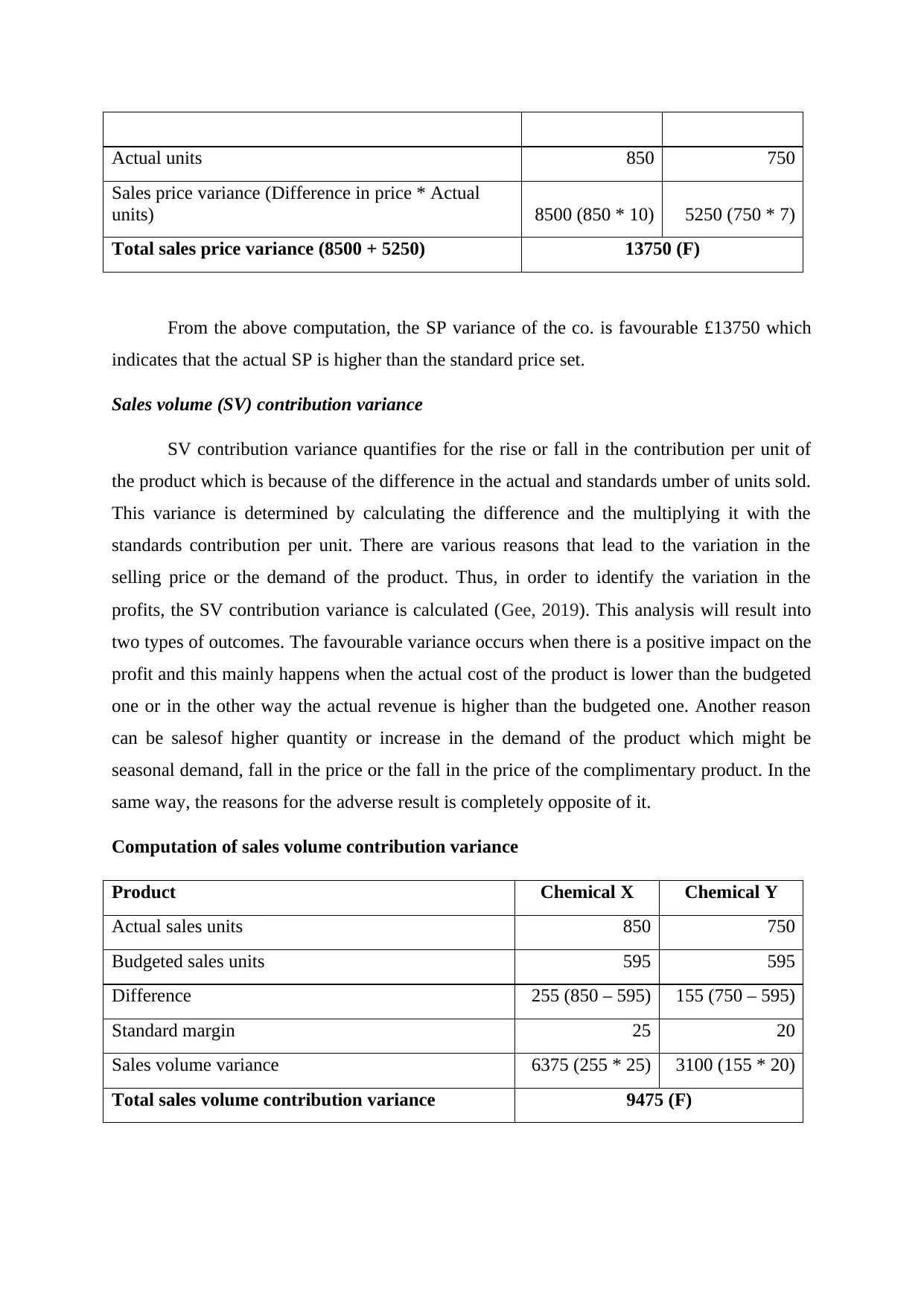
Actual units 850 750
Sales price variance (Difference in price * Actual
units) 8500 (850 * 10) 5250 (750 * 7)
Total sales price variance (8500 + 5250) 13750 (F)
From the above computation, the SP variance of the co. is favourable £13750 which
indicates that the actual SP is higher than the standard price set.
Sales volume (SV) contribution variance
SV contribution variance quantifies for the rise or fall in the contribution per unit of
the product which is because of the difference in the actual and standards umber of units sold.
This variance is determined by calculating the difference and the multiplying it with the
standards contribution per unit. There are various reasons that lead to the variation in the
selling price or the demand of the product. Thus, in order to identify the variation in the
profits, the SV contribution variance is calculated (Gee, 2019). This analysis will result into
two types of outcomes. The favourable variance occurs when there is a positive impact on the
profit and this mainly happens when the actual cost of the product is lower than the budgeted
one or in the other way the actual revenue is higher than the budgeted one. Another reason
can be salesof higher quantity or increase in the demand of the product which might be
seasonal demand, fall in the price or the fall in the price of the complimentary product. In the
same way, the reasons for the adverse result is completely opposite of it.
Computation of sales volume contribution variance
Product Chemical X Chemical Y
Actual sales units 850 750
Budgeted sales units 595 595
Difference 255 (850 – 595) 155 (750 – 595)
Standard margin 25 20
Sales volume variance 6375 (255 * 25) 3100 (155 * 20)
Total sales volume contribution variance 9475 (F)
Sales price variance (Difference in price * Actual
units) 8500 (850 * 10) 5250 (750 * 7)
Total sales price variance (8500 + 5250) 13750 (F)
From the above computation, the SP variance of the co. is favourable £13750 which
indicates that the actual SP is higher than the standard price set.
Sales volume (SV) contribution variance
SV contribution variance quantifies for the rise or fall in the contribution per unit of
the product which is because of the difference in the actual and standards umber of units sold.
This variance is determined by calculating the difference and the multiplying it with the
standards contribution per unit. There are various reasons that lead to the variation in the
selling price or the demand of the product. Thus, in order to identify the variation in the
profits, the SV contribution variance is calculated (Gee, 2019). This analysis will result into
two types of outcomes. The favourable variance occurs when there is a positive impact on the
profit and this mainly happens when the actual cost of the product is lower than the budgeted
one or in the other way the actual revenue is higher than the budgeted one. Another reason
can be salesof higher quantity or increase in the demand of the product which might be
seasonal demand, fall in the price or the fall in the price of the complimentary product. In the
same way, the reasons for the adverse result is completely opposite of it.
Computation of sales volume contribution variance
Product Chemical X Chemical Y
Actual sales units 850 750
Budgeted sales units 595 595
Difference 255 (850 – 595) 155 (750 – 595)
Standard margin 25 20
Sales volume variance 6375 (255 * 25) 3100 (155 * 20)
Total sales volume contribution variance 9475 (F)
Paraphrase This Document
Need a fresh take? Get an instant paraphrase of this document with our AI Paraphraser
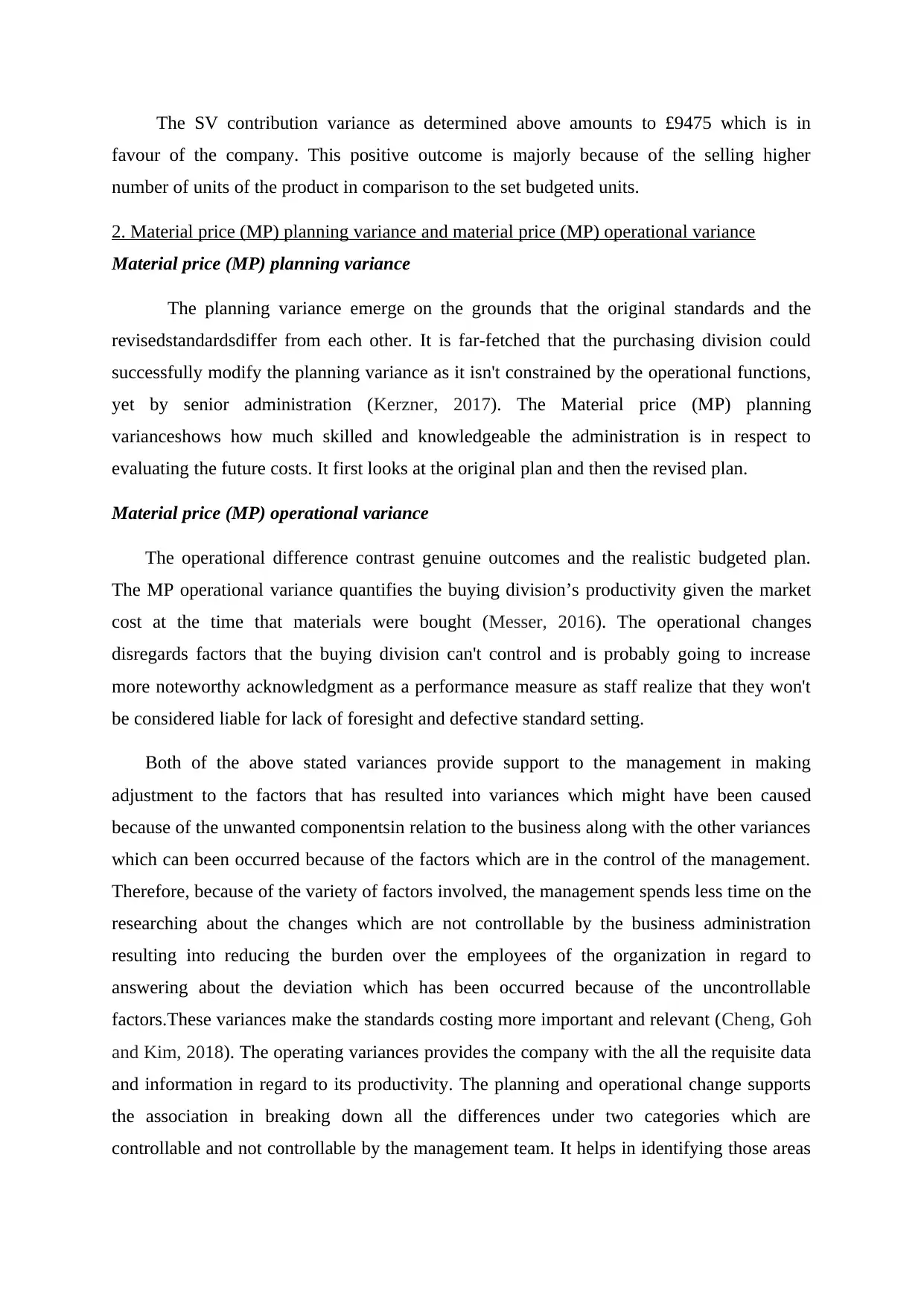
The SV contribution variance as determined above amounts to £9475 which is in
favour of the company. This positive outcome is majorly because of the selling higher
number of units of the product in comparison to the set budgeted units.
2. Material price (MP) planning variance and material price (MP) operational variance
Material price (MP) planning variance
The planning variance emerge on the grounds that the original standards and the
revisedstandardsdiffer from each other. It is far-fetched that the purchasing division could
successfully modify the planning variance as it isn't constrained by the operational functions,
yet by senior administration (Kerzner, 2017). The Material price (MP) planning
varianceshows how much skilled and knowledgeable the administration is in respect to
evaluating the future costs. It first looks at the original plan and then the revised plan.
Material price (MP) operational variance
The operational difference contrast genuine outcomes and the realistic budgeted plan.
The MP operational variance quantifies the buying division’s productivity given the market
cost at the time that materials were bought (Messer, 2016). The operational changes
disregards factors that the buying division can't control and is probably going to increase
more noteworthy acknowledgment as a performance measure as staff realize that they won't
be considered liable for lack of foresight and defective standard setting.
Both of the above stated variances provide support to the management in making
adjustment to the factors that has resulted into variances which might have been caused
because of the unwanted componentsin relation to the business along with the other variances
which can been occurred because of the factors which are in the control of the management.
Therefore, because of the variety of factors involved, the management spends less time on the
researching about the changes which are not controllable by the business administration
resulting into reducing the burden over the employees of the organization in regard to
answering about the deviation which has been occurred because of the uncontrollable
factors.These variances make the standards costing more important and relevant (Cheng, Goh
and Kim, 2018). The operating variances provides the company with the all the requisite data
and information in regard to its productivity. The planning and operational change supports
the association in breaking down all the differences under two categories which are
controllable and not controllable by the management team. It helps in identifying those areas
favour of the company. This positive outcome is majorly because of the selling higher
number of units of the product in comparison to the set budgeted units.
2. Material price (MP) planning variance and material price (MP) operational variance
Material price (MP) planning variance
The planning variance emerge on the grounds that the original standards and the
revisedstandardsdiffer from each other. It is far-fetched that the purchasing division could
successfully modify the planning variance as it isn't constrained by the operational functions,
yet by senior administration (Kerzner, 2017). The Material price (MP) planning
varianceshows how much skilled and knowledgeable the administration is in respect to
evaluating the future costs. It first looks at the original plan and then the revised plan.
Material price (MP) operational variance
The operational difference contrast genuine outcomes and the realistic budgeted plan.
The MP operational variance quantifies the buying division’s productivity given the market
cost at the time that materials were bought (Messer, 2016). The operational changes
disregards factors that the buying division can't control and is probably going to increase
more noteworthy acknowledgment as a performance measure as staff realize that they won't
be considered liable for lack of foresight and defective standard setting.
Both of the above stated variances provide support to the management in making
adjustment to the factors that has resulted into variances which might have been caused
because of the unwanted componentsin relation to the business along with the other variances
which can been occurred because of the factors which are in the control of the management.
Therefore, because of the variety of factors involved, the management spends less time on the
researching about the changes which are not controllable by the business administration
resulting into reducing the burden over the employees of the organization in regard to
answering about the deviation which has been occurred because of the uncontrollable
factors.These variances make the standards costing more important and relevant (Cheng, Goh
and Kim, 2018). The operating variances provides the company with the all the requisite data
and information in regard to its productivity. The planning and operational change supports
the association in breaking down all the differences under two categories which are
controllable and not controllable by the management team. It helps in identifying those areas

where in where the actual result does not match up with the planned one resulting into
unfavourable results.
Calculation of material price planning variance
Product Original
budget
Revised
budget
Actual
Chemical X 2.5 4.5 3.7
Chemical Y 2.5 4.5 3.7
Budgeted production 800 800 1600 (800 +
800)
Material price (MP) planning
variance
(4.5 - 2.5)
*1600
3200 (A)
The above calculations depict that the material price (MP) planning variance, is
adverse as the revised budgeted price is higher than the originally budgeted which resulted
into incurring more cost in respect to the material.
Calculationof material price operational variance
Product
Original
budget Revised budget Actual
Chemical X 2.5 4.5 3.7
Chemical Y 2.5 4.5 3.7
Budgeted production 800 800 1600
Material price (MP) operational
variance
(3.7 - 4.5)
*1600 -1280 (F)
The MP operational variance is favourable actual material price is lower than the
revised material price for the same number of units and this has resulted into positive or the
favourable outcomes.
unfavourable results.
Calculation of material price planning variance
Product Original
budget
Revised
budget
Actual
Chemical X 2.5 4.5 3.7
Chemical Y 2.5 4.5 3.7
Budgeted production 800 800 1600 (800 +
800)
Material price (MP) planning
variance
(4.5 - 2.5)
*1600
3200 (A)
The above calculations depict that the material price (MP) planning variance, is
adverse as the revised budgeted price is higher than the originally budgeted which resulted
into incurring more cost in respect to the material.
Calculationof material price operational variance
Product
Original
budget Revised budget Actual
Chemical X 2.5 4.5 3.7
Chemical Y 2.5 4.5 3.7
Budgeted production 800 800 1600
Material price (MP) operational
variance
(3.7 - 4.5)
*1600 -1280 (F)
The MP operational variance is favourable actual material price is lower than the
revised material price for the same number of units and this has resulted into positive or the
favourable outcomes.
⊘ This is a preview!⊘
Do you want full access?
Subscribe today to unlock all pages.

Trusted by 1+ million students worldwide
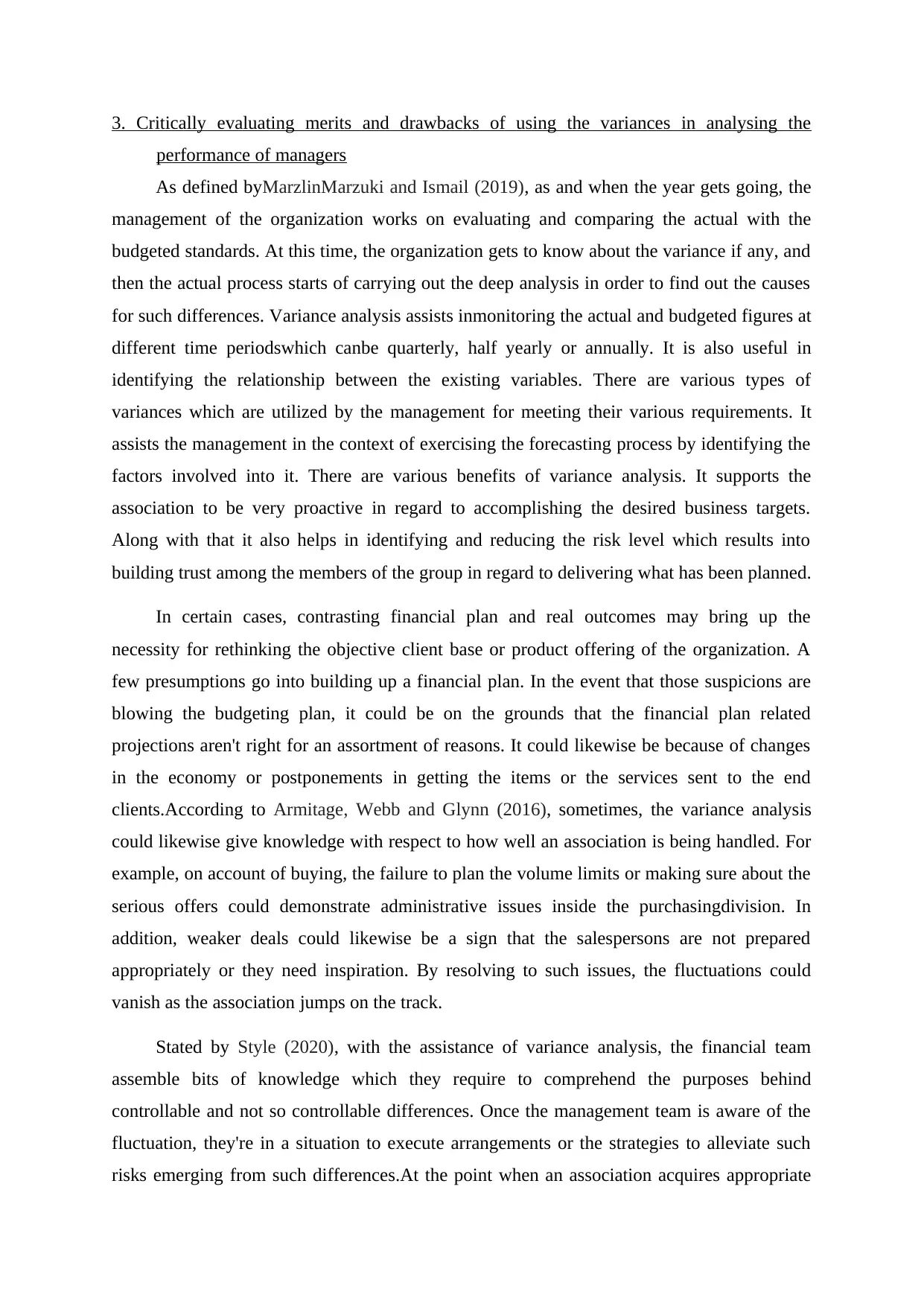
3. Critically evaluating merits and drawbacks of using the variances in analysing the
performance of managers
As defined byMarzlinMarzuki and Ismail (2019), as and when the year gets going, the
management of the organization works on evaluating and comparing the actual with the
budgeted standards. At this time, the organization gets to know about the variance if any, and
then the actual process starts of carrying out the deep analysis in order to find out the causes
for such differences. Variance analysis assists inmonitoring the actual and budgeted figures at
different time periodswhich canbe quarterly, half yearly or annually. It is also useful in
identifying the relationship between the existing variables. There are various types of
variances which are utilized by the management for meeting their various requirements. It
assists the management in the context of exercising the forecasting process by identifying the
factors involved into it. There are various benefits of variance analysis. It supports the
association to be very proactive in regard to accomplishing the desired business targets.
Along with that it also helps in identifying and reducing the risk level which results into
building trust among the members of the group in regard to delivering what has been planned.
In certain cases, contrasting financial plan and real outcomes may bring up the
necessity for rethinking the objective client base or product offering of the organization. A
few presumptions go into building up a financial plan. In the event that those suspicions are
blowing the budgeting plan, it could be on the grounds that the financial plan related
projections aren't right for an assortment of reasons. It could likewise be because of changes
in the economy or postponements in getting the items or the services sent to the end
clients.According to Armitage, Webb and Glynn (2016), sometimes, the variance analysis
could likewise give knowledge with respect to how well an association is being handled. For
example, on account of buying, the failure to plan the volume limits or making sure about the
serious offers could demonstrate administrative issues inside the purchasingdivision. In
addition, weaker deals could likewise be a sign that the salespersons are not prepared
appropriately or they need inspiration. By resolving to such issues, the fluctuations could
vanish as the association jumps on the track.
Stated by Style (2020), with the assistance of variance analysis, the financial team
assemble bits of knowledge which they require to comprehend the purposes behind
controllable and not so controllable differences. Once the management team is aware of the
fluctuation, they're in a situation to execute arrangements or the strategies to alleviate such
risks emerging from such differences.At the point when an association acquires appropriate
performance of managers
As defined byMarzlinMarzuki and Ismail (2019), as and when the year gets going, the
management of the organization works on evaluating and comparing the actual with the
budgeted standards. At this time, the organization gets to know about the variance if any, and
then the actual process starts of carrying out the deep analysis in order to find out the causes
for such differences. Variance analysis assists inmonitoring the actual and budgeted figures at
different time periodswhich canbe quarterly, half yearly or annually. It is also useful in
identifying the relationship between the existing variables. There are various types of
variances which are utilized by the management for meeting their various requirements. It
assists the management in the context of exercising the forecasting process by identifying the
factors involved into it. There are various benefits of variance analysis. It supports the
association to be very proactive in regard to accomplishing the desired business targets.
Along with that it also helps in identifying and reducing the risk level which results into
building trust among the members of the group in regard to delivering what has been planned.
In certain cases, contrasting financial plan and real outcomes may bring up the
necessity for rethinking the objective client base or product offering of the organization. A
few presumptions go into building up a financial plan. In the event that those suspicions are
blowing the budgeting plan, it could be on the grounds that the financial plan related
projections aren't right for an assortment of reasons. It could likewise be because of changes
in the economy or postponements in getting the items or the services sent to the end
clients.According to Armitage, Webb and Glynn (2016), sometimes, the variance analysis
could likewise give knowledge with respect to how well an association is being handled. For
example, on account of buying, the failure to plan the volume limits or making sure about the
serious offers could demonstrate administrative issues inside the purchasingdivision. In
addition, weaker deals could likewise be a sign that the salespersons are not prepared
appropriately or they need inspiration. By resolving to such issues, the fluctuations could
vanish as the association jumps on the track.
Stated by Style (2020), with the assistance of variance analysis, the financial team
assemble bits of knowledge which they require to comprehend the purposes behind
controllable and not so controllable differences. Once the management team is aware of the
fluctuation, they're in a situation to execute arrangements or the strategies to alleviate such
risks emerging from such differences.At the point when an association acquires appropriate
Paraphrase This Document
Need a fresh take? Get an instant paraphrase of this document with our AI Paraphraser
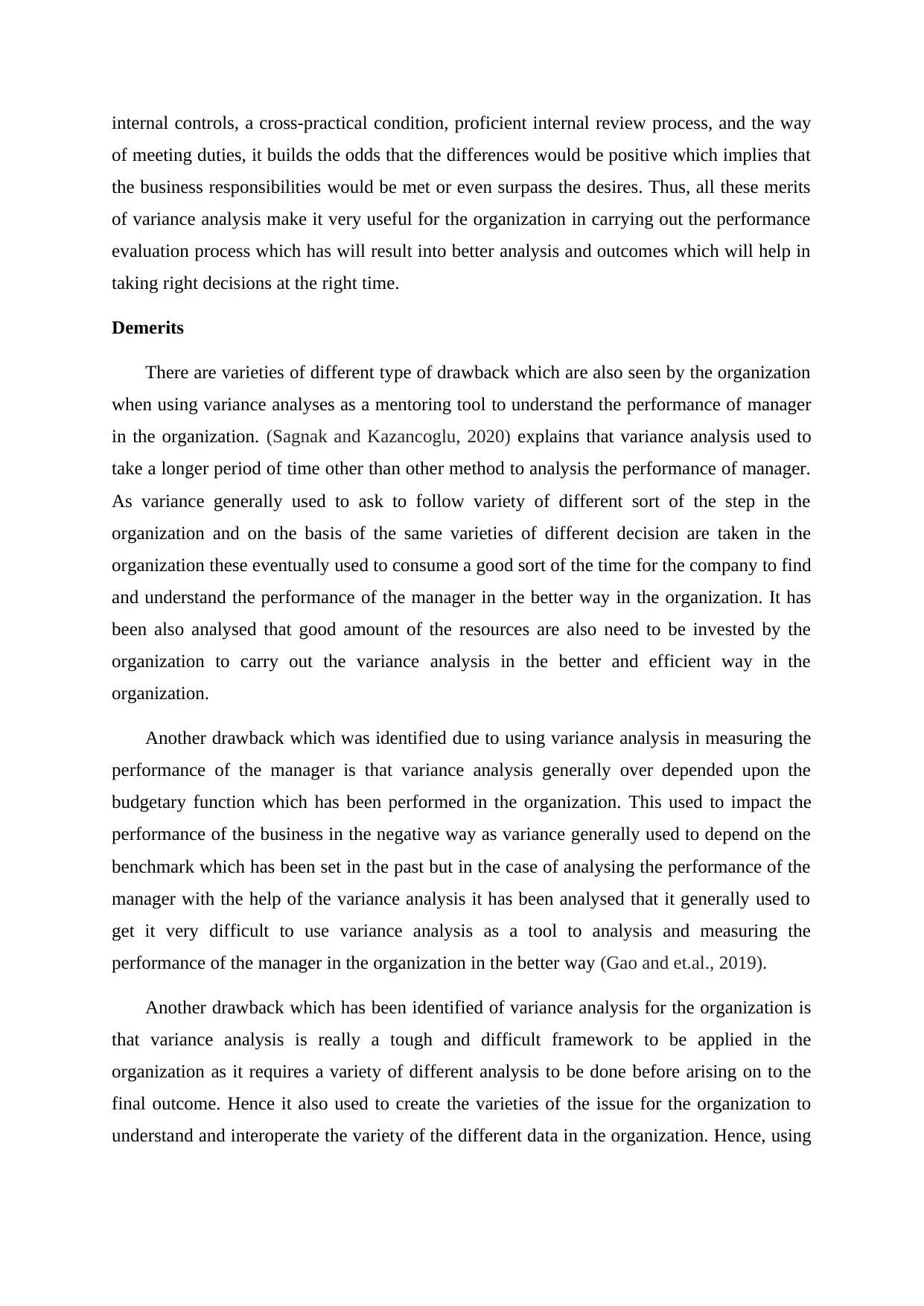
internal controls, a cross-practical condition, proficient internal review process, and the way
of meeting duties, it builds the odds that the differences would be positive which implies that
the business responsibilities would be met or even surpass the desires. Thus, all these merits
of variance analysis make it very useful for the organization in carrying out the performance
evaluation process which has will result into better analysis and outcomes which will help in
taking right decisions at the right time.
Demerits
There are varieties of different type of drawback which are also seen by the organization
when using variance analyses as a mentoring tool to understand the performance of manager
in the organization. (Sagnak and Kazancoglu, 2020) explains that variance analysis used to
take a longer period of time other than other method to analysis the performance of manager.
As variance generally used to ask to follow variety of different sort of the step in the
organization and on the basis of the same varieties of different decision are taken in the
organization these eventually used to consume a good sort of the time for the company to find
and understand the performance of the manager in the better way in the organization. It has
been also analysed that good amount of the resources are also need to be invested by the
organization to carry out the variance analysis in the better and efficient way in the
organization.
Another drawback which was identified due to using variance analysis in measuring the
performance of the manager is that variance analysis generally over depended upon the
budgetary function which has been performed in the organization. This used to impact the
performance of the business in the negative way as variance generally used to depend on the
benchmark which has been set in the past but in the case of analysing the performance of the
manager with the help of the variance analysis it has been analysed that it generally used to
get it very difficult to use variance analysis as a tool to analysis and measuring the
performance of the manager in the organization in the better way (Gao and et.al., 2019).
Another drawback which has been identified of variance analysis for the organization is
that variance analysis is really a tough and difficult framework to be applied in the
organization as it requires a variety of different analysis to be done before arising on to the
final outcome. Hence it also used to create the varieties of the issue for the organization to
understand and interoperate the variety of the different data in the organization. Hence, using
of meeting duties, it builds the odds that the differences would be positive which implies that
the business responsibilities would be met or even surpass the desires. Thus, all these merits
of variance analysis make it very useful for the organization in carrying out the performance
evaluation process which has will result into better analysis and outcomes which will help in
taking right decisions at the right time.
Demerits
There are varieties of different type of drawback which are also seen by the organization
when using variance analyses as a mentoring tool to understand the performance of manager
in the organization. (Sagnak and Kazancoglu, 2020) explains that variance analysis used to
take a longer period of time other than other method to analysis the performance of manager.
As variance generally used to ask to follow variety of different sort of the step in the
organization and on the basis of the same varieties of different decision are taken in the
organization these eventually used to consume a good sort of the time for the company to find
and understand the performance of the manager in the better way in the organization. It has
been also analysed that good amount of the resources are also need to be invested by the
organization to carry out the variance analysis in the better and efficient way in the
organization.
Another drawback which was identified due to using variance analysis in measuring the
performance of the manager is that variance analysis generally over depended upon the
budgetary function which has been performed in the organization. This used to impact the
performance of the business in the negative way as variance generally used to depend on the
benchmark which has been set in the past but in the case of analysing the performance of the
manager with the help of the variance analysis it has been analysed that it generally used to
get it very difficult to use variance analysis as a tool to analysis and measuring the
performance of the manager in the organization in the better way (Gao and et.al., 2019).
Another drawback which has been identified of variance analysis for the organization is
that variance analysis is really a tough and difficult framework to be applied in the
organization as it requires a variety of different analysis to be done before arising on to the
final outcome. Hence it also used to create the varieties of the issue for the organization to
understand and interoperate the variety of the different data in the organization. Hence, using
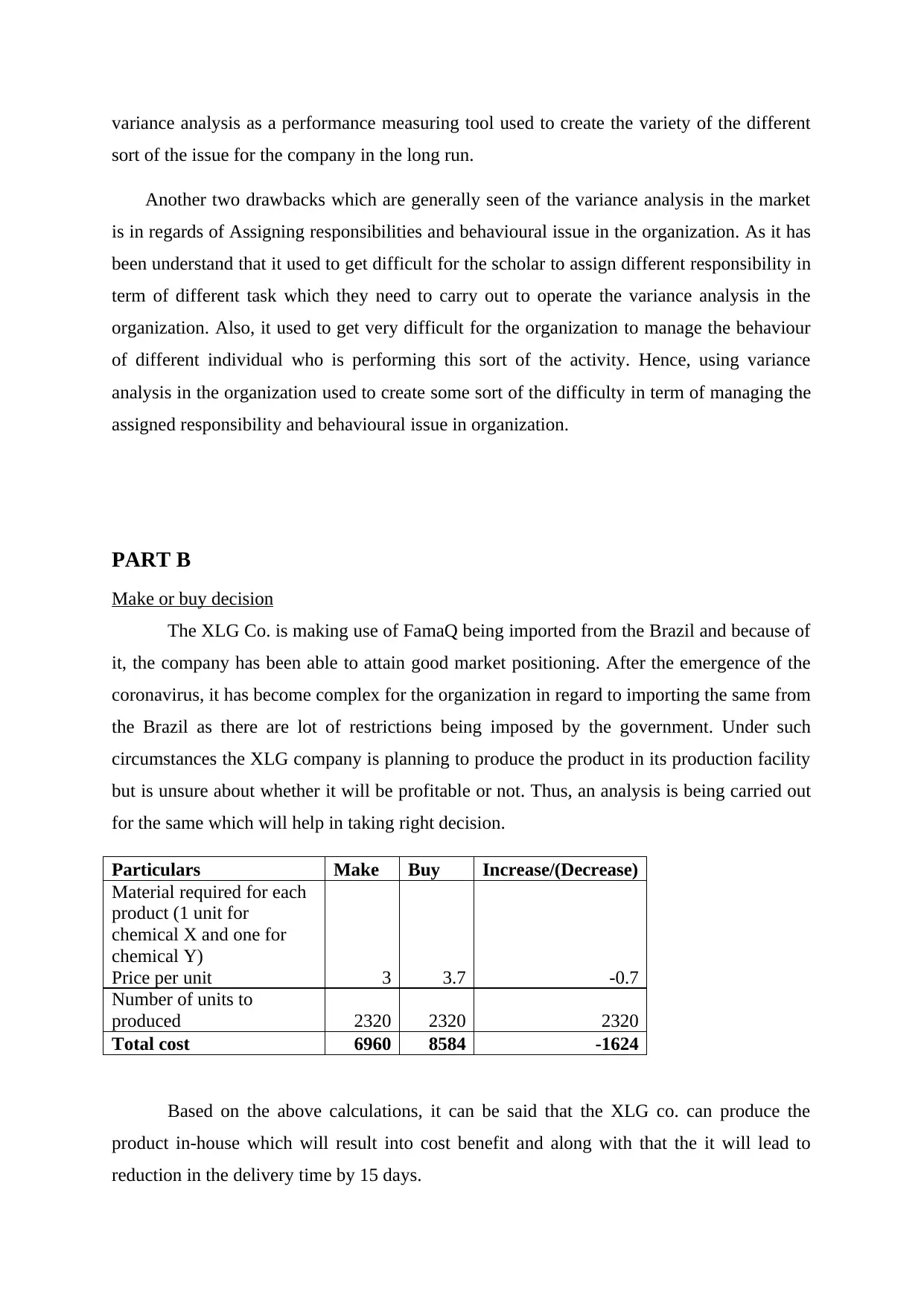
variance analysis as a performance measuring tool used to create the variety of the different
sort of the issue for the company in the long run.
Another two drawbacks which are generally seen of the variance analysis in the market
is in regards of Assigning responsibilities and behavioural issue in the organization. As it has
been understand that it used to get difficult for the scholar to assign different responsibility in
term of different task which they need to carry out to operate the variance analysis in the
organization. Also, it used to get very difficult for the organization to manage the behaviour
of different individual who is performing this sort of the activity. Hence, using variance
analysis in the organization used to create some sort of the difficulty in term of managing the
assigned responsibility and behavioural issue in organization.
PART B
Make or buy decision
The XLG Co. is making use of FamaQ being imported from the Brazil and because of
it, the company has been able to attain good market positioning. After the emergence of the
coronavirus, it has become complex for the organization in regard to importing the same from
the Brazil as there are lot of restrictions being imposed by the government. Under such
circumstances the XLG company is planning to produce the product in its production facility
but is unsure about whether it will be profitable or not. Thus, an analysis is being carried out
for the same which will help in taking right decision.
Particulars Make Buy Increase/(Decrease)
Material required for each
product (1 unit for
chemical X and one for
chemical Y)
Price per unit 3 3.7 -0.7
Number of units to
produced 2320 2320 2320
Total cost 6960 8584 -1624
Based on the above calculations, it can be said that the XLG co. can produce the
product in-house which will result into cost benefit and along with that the it will lead to
reduction in the delivery time by 15 days.
sort of the issue for the company in the long run.
Another two drawbacks which are generally seen of the variance analysis in the market
is in regards of Assigning responsibilities and behavioural issue in the organization. As it has
been understand that it used to get difficult for the scholar to assign different responsibility in
term of different task which they need to carry out to operate the variance analysis in the
organization. Also, it used to get very difficult for the organization to manage the behaviour
of different individual who is performing this sort of the activity. Hence, using variance
analysis in the organization used to create some sort of the difficulty in term of managing the
assigned responsibility and behavioural issue in organization.
PART B
Make or buy decision
The XLG Co. is making use of FamaQ being imported from the Brazil and because of
it, the company has been able to attain good market positioning. After the emergence of the
coronavirus, it has become complex for the organization in regard to importing the same from
the Brazil as there are lot of restrictions being imposed by the government. Under such
circumstances the XLG company is planning to produce the product in its production facility
but is unsure about whether it will be profitable or not. Thus, an analysis is being carried out
for the same which will help in taking right decision.
Particulars Make Buy Increase/(Decrease)
Material required for each
product (1 unit for
chemical X and one for
chemical Y)
Price per unit 3 3.7 -0.7
Number of units to
produced 2320 2320 2320
Total cost 6960 8584 -1624
Based on the above calculations, it can be said that the XLG co. can produce the
product in-house which will result into cost benefit and along with that the it will lead to
reduction in the delivery time by 15 days.
⊘ This is a preview!⊘
Do you want full access?
Subscribe today to unlock all pages.

Trusted by 1+ million students worldwide
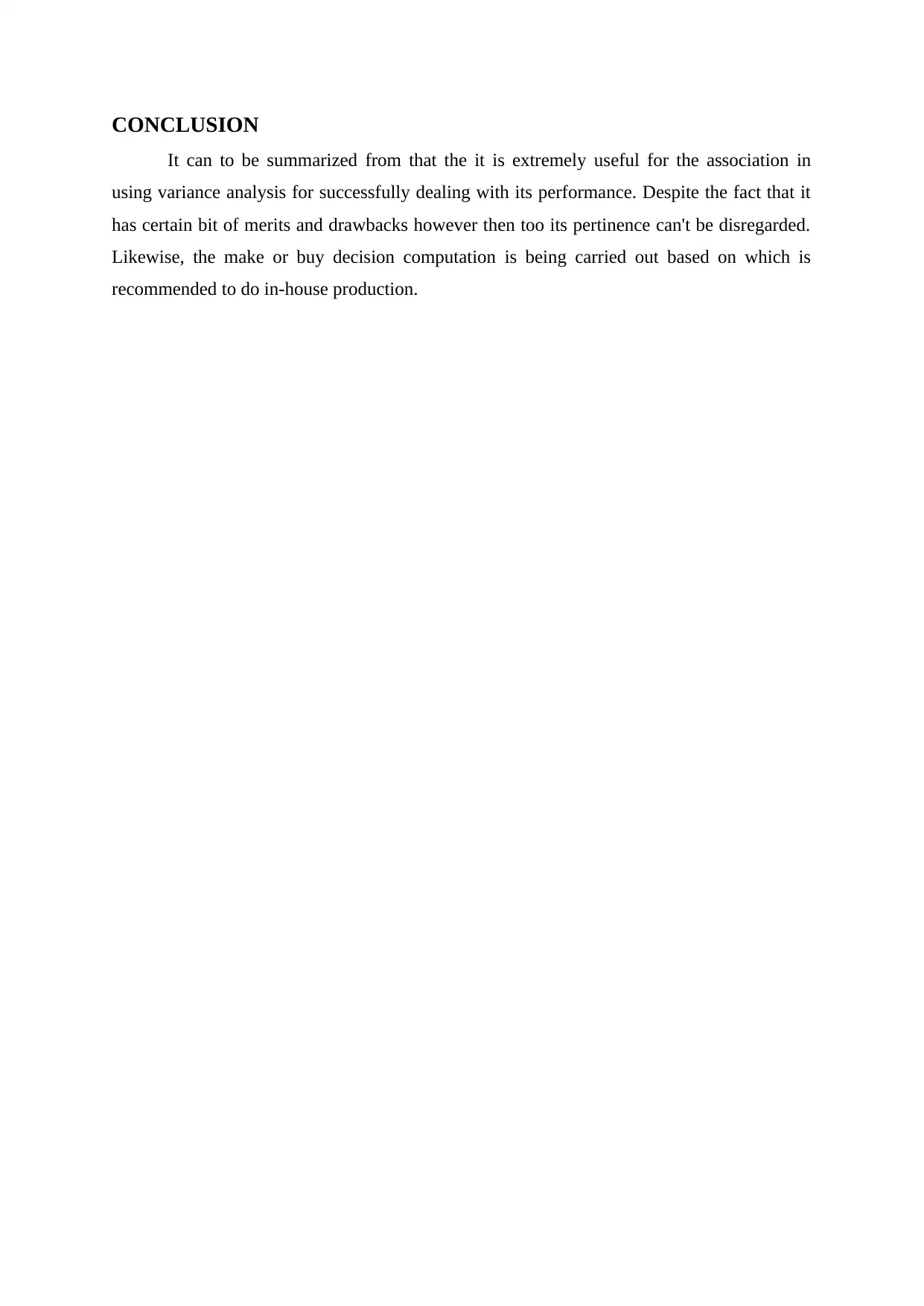
CONCLUSION
It can to be summarized from that the it is extremely useful for the association in
using variance analysis for successfully dealing with its performance. Despite the fact that it
has certain bit of merits and drawbacks however then too its pertinence can't be disregarded.
Likewise, the make or buy decision computation is being carried out based on which is
recommended to do in-house production.
It can to be summarized from that the it is extremely useful for the association in
using variance analysis for successfully dealing with its performance. Despite the fact that it
has certain bit of merits and drawbacks however then too its pertinence can't be disregarded.
Likewise, the make or buy decision computation is being carried out based on which is
recommended to do in-house production.
Paraphrase This Document
Need a fresh take? Get an instant paraphrase of this document with our AI Paraphraser
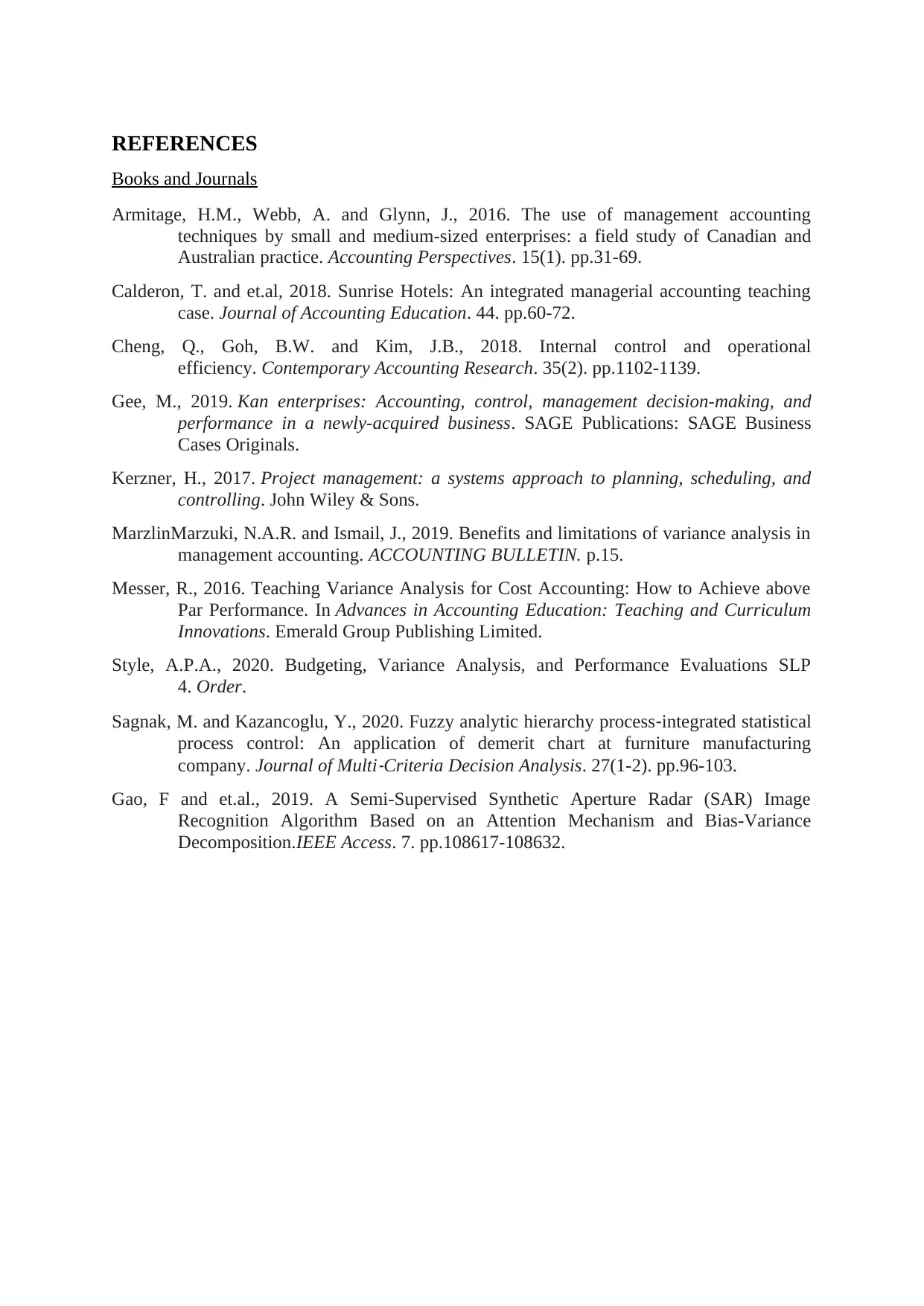
REFERENCES
Books and Journals
Armitage, H.M., Webb, A. and Glynn, J., 2016. The use of management accounting
techniques by small and medium‐sized enterprises: a field study of Canadian and
Australian practice. Accounting Perspectives. 15(1). pp.31-69.
Calderon, T. and et.al, 2018. Sunrise Hotels: An integrated managerial accounting teaching
case. Journal of Accounting Education. 44. pp.60-72.
Cheng, Q., Goh, B.W. and Kim, J.B., 2018. Internal control and operational
efficiency. Contemporary Accounting Research. 35(2). pp.1102-1139.
Gee, M., 2019. Kan enterprises: Accounting, control, management decision-making, and
performance in a newly-acquired business. SAGE Publications: SAGE Business
Cases Originals.
Kerzner, H., 2017. Project management: a systems approach to planning, scheduling, and
controlling. John Wiley & Sons.
MarzlinMarzuki, N.A.R. and Ismail, J., 2019. Benefits and limitations of variance analysis in
management accounting. ACCOUNTING BULLETIN. p.15.
Messer, R., 2016. Teaching Variance Analysis for Cost Accounting: How to Achieve above
Par Performance. In Advances in Accounting Education: Teaching and Curriculum
Innovations. Emerald Group Publishing Limited.
Style, A.P.A., 2020. Budgeting, Variance Analysis, and Performance Evaluations SLP
4. Order.
Sagnak, M. and Kazancoglu, Y., 2020. Fuzzy analytic hierarchy process‐integrated statistical
process control: An application of demerit chart at furniture manufacturing
company. Journal of Multi
‐Criteria Decision Analysis. 27(1-2). pp.96-103.
Gao, F and et.al., 2019. A Semi-Supervised Synthetic Aperture Radar (SAR) Image
Recognition Algorithm Based on an Attention Mechanism and Bias-Variance
Decomposition.IEEE Access. 7. pp.108617-108632.
Books and Journals
Armitage, H.M., Webb, A. and Glynn, J., 2016. The use of management accounting
techniques by small and medium‐sized enterprises: a field study of Canadian and
Australian practice. Accounting Perspectives. 15(1). pp.31-69.
Calderon, T. and et.al, 2018. Sunrise Hotels: An integrated managerial accounting teaching
case. Journal of Accounting Education. 44. pp.60-72.
Cheng, Q., Goh, B.W. and Kim, J.B., 2018. Internal control and operational
efficiency. Contemporary Accounting Research. 35(2). pp.1102-1139.
Gee, M., 2019. Kan enterprises: Accounting, control, management decision-making, and
performance in a newly-acquired business. SAGE Publications: SAGE Business
Cases Originals.
Kerzner, H., 2017. Project management: a systems approach to planning, scheduling, and
controlling. John Wiley & Sons.
MarzlinMarzuki, N.A.R. and Ismail, J., 2019. Benefits and limitations of variance analysis in
management accounting. ACCOUNTING BULLETIN. p.15.
Messer, R., 2016. Teaching Variance Analysis for Cost Accounting: How to Achieve above
Par Performance. In Advances in Accounting Education: Teaching and Curriculum
Innovations. Emerald Group Publishing Limited.
Style, A.P.A., 2020. Budgeting, Variance Analysis, and Performance Evaluations SLP
4. Order.
Sagnak, M. and Kazancoglu, Y., 2020. Fuzzy analytic hierarchy process‐integrated statistical
process control: An application of demerit chart at furniture manufacturing
company. Journal of Multi
‐Criteria Decision Analysis. 27(1-2). pp.96-103.
Gao, F and et.al., 2019. A Semi-Supervised Synthetic Aperture Radar (SAR) Image
Recognition Algorithm Based on an Attention Mechanism and Bias-Variance
Decomposition.IEEE Access. 7. pp.108617-108632.
1 out of 11
Related Documents
Your All-in-One AI-Powered Toolkit for Academic Success.
+13062052269
info@desklib.com
Available 24*7 on WhatsApp / Email
![[object Object]](/_next/static/media/star-bottom.7253800d.svg)
Unlock your academic potential
Copyright © 2020–2025 A2Z Services. All Rights Reserved. Developed and managed by ZUCOL.





